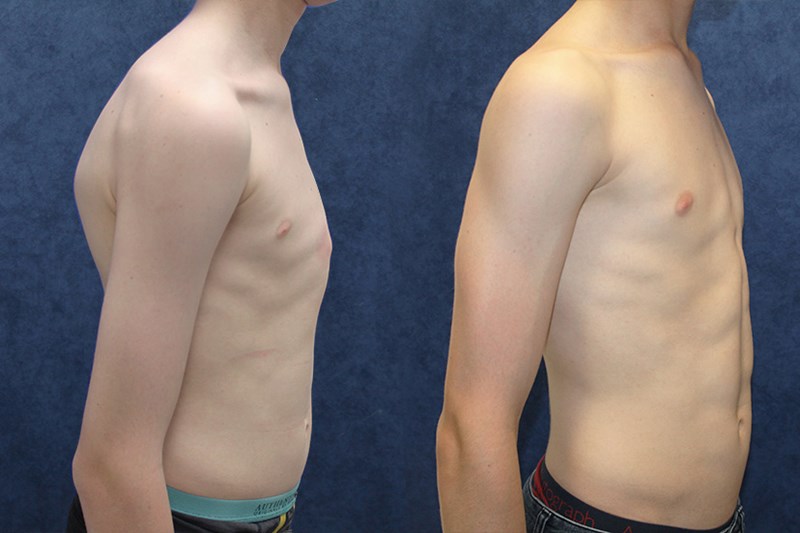
19 July 2018
Feeling self-conscious about one’s appearance is almost a rite of passage for teenagers today, but for young people with pectus carinatum, that anxiety can be considerably heightened. Pectus carinatum, also known as 'pigeon chest', is a congenital deformity of the anterior chest wall, which occurs when the breast bone is pushed outward by an abnormal overgrowth of cartilage, causing visible protrusion of the bone and, in some cases, other related symptoms, such as respiratory problems. It affects around one in 1,500 people and although present at birth, it often becomes more noticeable in early adolescence when the ribcage and the rest of the body undergo growth spurts during puberty.
Recently we had a 14-year-old pectus patient who attended The London Orthotic Consultancy for treatment for his pectus carinatum inferior with rib flaring after only being offered surgical solutions on the NHS. While this is a well-established method of treatment, it carries the associated complications of having a general anaesthetic, does not address the problem of the flaring of the ribs, and patients can be left with visible scarring.
“He was 14 at the time and was eager to find a non-surgical treatment option to improve the appearance of his chest wall,” says LOC clinician Sam Walmsley.” His age made him an ideal candidate for our non-surgical LOCpectus treatment, as the chest is more malleable in adolescents than adults, becoming stiffer as the skeleton matures, which can make results harder to achieve.

Above: The Dynamic Chest Compressor applies pressure to the carinatum area of the chest
This young man’s treatment involved wearing a bespoke brace, the Dynamic Chest Compressor, which applied constant pressure over the area of his chest that needed to be remodelled. Because pectus carinatum is caused by the chest protruding, we use a brace that fits over the apex of the chest to push it in – the dynamic chest compressor 1 – for the upper chest. In cases where the ribs protrude as well, such as in this instance, the lower dynamic chest compressor 2 is also required. As you push the upper chest inwards, the ribs tend to flare out, hence we use this lower brace to push the ribs back in. In addition, he was given a programme of daily exercises to follow.”
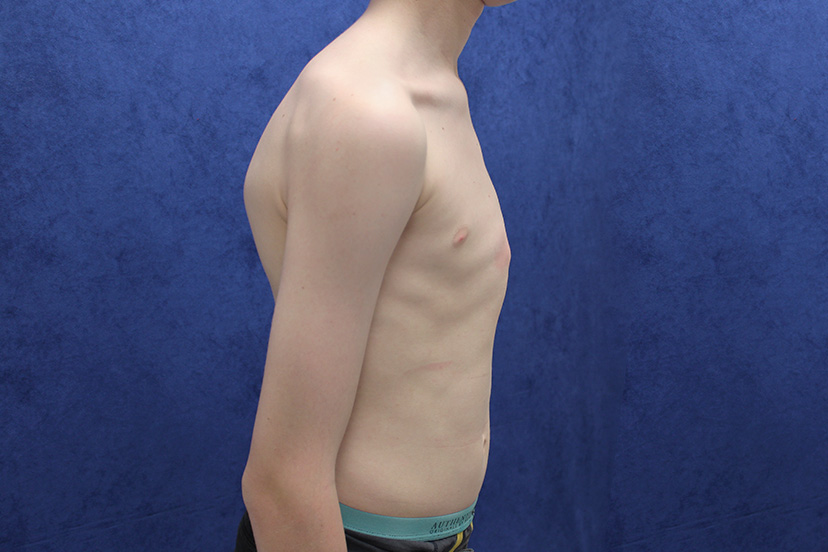
Above: Profile view of chest before bracing treatment
Length of treatment varies depending on the age of the patient, the elasticity of the chest and the severity of the condition. “His treatment here at The London Orthotic Consultancy lasted a period of 15 months, however, he successfully achieved a flat chest after only six months [see before and after photographs which show significant improvement],” says Sam. “The remaining nine months consisted of night-time brace use only, in order to maintain the much-improved appearance throughout his growth spurts.”
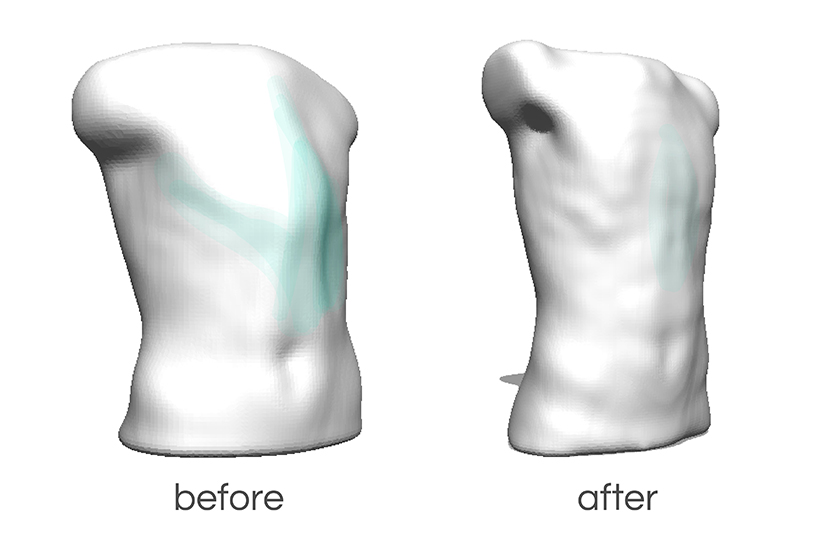
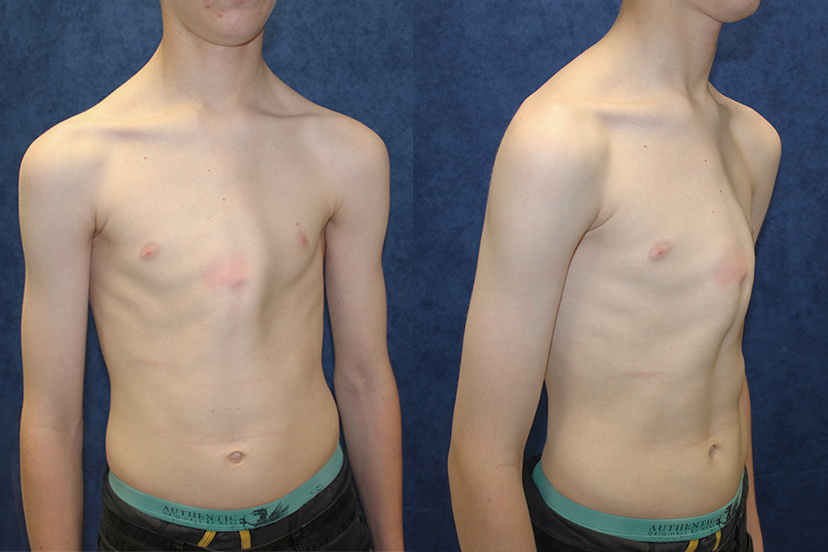
Above: Before treatment
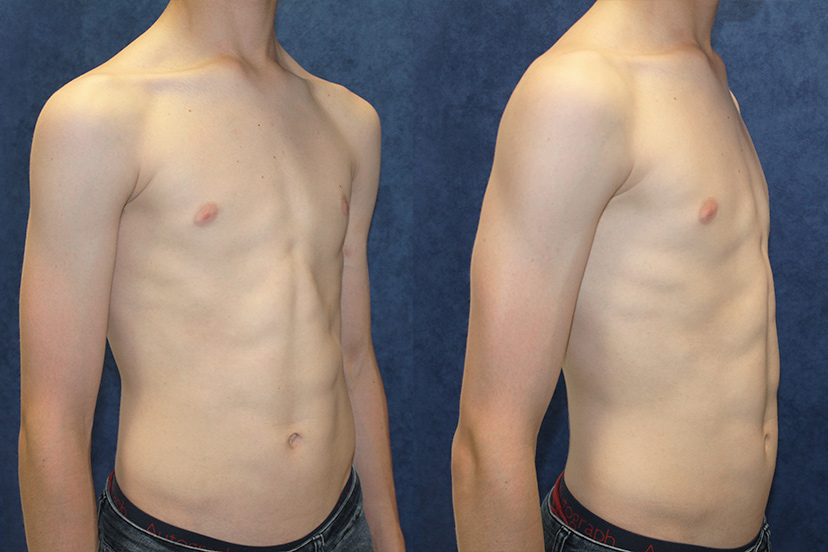
Above: After treatment
This patient’s chest shape is now completely stable. “He was delighted with the outcome and continues to be happy with his chest shape,” says Sam.
Now 18, this young man feels confident in his appearance and credits the success of the LOCpectus treatment with his restored self-esteem. Like many others, the most compelling reason for seeking correction of his pectus carinatum was the negative self-image it caused. Research shows that the psychological repercussions of having such a condition often outweigh the physical discomfort, with many finding it difficult to interact with others. Both he and his parents agree that contacting The London Orthotic Consultancy was the best decision they ever made.
If you are considering LOC’s non-surgical treatment for pectus carinatum, contact us for a free initial consultation, with no obligation to proceed. During the consultation, one of LOC's clinicians will examine your chest and general posture, determine the structural type of pectus that you have and the correction possible with our LOCpectus treatment programme.
If the clinician believes that your chest shape will respond using the dynamic remodelling method and that you are willing to commit to the exercise programme, they will take a series of photographs and 3D scans of your chest shape.
Further appointments will be made for casting and fitting and you will need to attend the clinic for regular reviews (for overseas patients, reviews can be conducted via Skype). We would love to help you with your pectus worries.
This depends on several factors; the position of the chest wall deformity, its severity, the flexibility of the chest, the kind of results wanting to be achieved and the age of the person undergoing treatment for pectus excavatum or pectus carinatum.
Early adolescence (roughly between the ages of 12-16 years old) – is an optimum age to start treatment, given that the chest is still maturing, and flexible, permanent correction is more easily achievable. Once bracing treatment is complete and a patient has stopped growing, the deformity will not return. For younger pectus patients, conservative bracing is used to keep a deformity from worsening and can help them to avoid surgery in later life.
For older pectus patients (between the ages of 20 to 30) results can be harder to achieve, as the costal cartilage hardens into the bone as a person matures. Over the years we have successfully treated many adults for both pectus excavatum and pectus carinatum and active adults with flexible chests can expect good results.
Again, this hugely depends on what a patient wants to achieve from treatment; whether that’s avoidance of surgery, improvement in the appearance of the chest shape, reduction in rib flaring etc. All these goals are taken into consideration during your first consultation. While there are no serious health risks of having pectus carinatum or excavatum – beyond the cosmetic – for many patients and parents, treatment outcomes involve improving confidence and self-esteem. During our 2018 Pectus Patient Survey, 92% of pectus carinatum patients surveyed said that treatment had a ‘major improvement’ or ‘an improvement’ on their social life.
You can read the results of our 2018 Pectus Patient Survey and quality of life questionnaire here.
Regular reviews are part of the treatment programme, preferably in clinic with one of our specialist orthotists, or via Skype consultations.
The number of appointments needed will vary from patient to patient but as a general rule, younger pectus patients who are growing at a faster rate will need to be seen more regularly for check-up appointments. This is to ensure that the brace fits well and is guiding the chest into the correct position as growth spurts occur. For other patients, this can be scaled back according to their individual needs and demands.
Regular appointments are beneficial for assessing progress, checking for signs of rubbing and determining whether another brace is needed. Appointments are also good for checking patient compliance to brace wearing and the breathing and exercise programme. At each appointment, we make time for patients to see our physiotherapist to fine-tune their exercise programme and check to see how a patient has been managing with the current programme.
We always advise coming in for appointments whenever you have any concerns about the brace or treatment programme, especially if a brace is rubbing or not fitting correctly. At the London Orthotic Consultancy, we have treated numerous international patients that have benefitted from specially designed braces that leave room to accommodate for growth and that can be adjusted remotely. Follow-up appointments for international patients are conducted via Skype.
This is a very common concern for patients considering treatment; in general, the dynamic chest compressor brace is easy to conceal if you are wearing a loose-fitting shirt for school or work. If you are wearing two chest braces – one for the main deformity and the other for rib flaring – then this may be more noticeable, especially under a t-shirt. Normally loose-fitting clothing will conceal the brace, though it’s likely it will be seen through tight-fitting clothes.
It is really important to continue exercising while going through bracing treatment. Exercise is fundamental to keeping the chest wall flexible. Our treatment programme incorporates a daily exercise routine of around 30-40 minutes of stretching using yoga poses, resistance bands, deep breathing exercises and general muscle stretches. Deep breathing exercises allow the lungs to expand against the chest wall, pushing it outwards.
Exercising with the brace on in the later stages of treatment can also make the chest correction more stable and permanent.
Swimming is one of the best forms of exercise to complement bracing treatment, as the body positions required to swim imitate the resistance band training designed to stretch the chest and increase its flexibility. Some swimming strokes are better for this than others, please check with your clinician. The brace should always be removed for contact sports and for swimming.
For most patients, one brace is often all that is needed to achieve a desired level of correction. They are each designed to last the duration of treatment and accommodate any growth that may occur in that time. Some patients have benefitted from having two braces – one to treat the main deformity and the other to treat rib flaring. For some pectus excavatum patients, having a brace apply pressure to the ribs – in addition to vacuum bell therapy – can greatly reduce the appearance of the depressed sternum area of the chest, forcing it upwards and outwards into a more corrective position.
If you are worried about your chest shape, or your child’s chest shape, then get in touch for a free Skype consultation with one of our pectus specialists who can assess their chest and discuss treatment options. We are always happy to communicate with local GPs, thoracic surgeons and consultants if a patient approaches us for bracing treatment after considering other options.